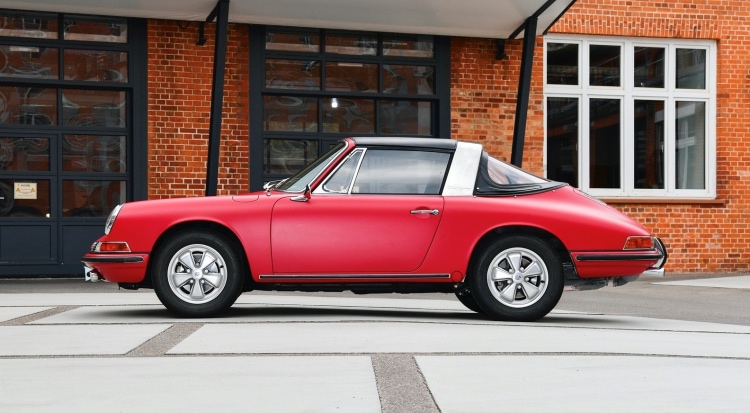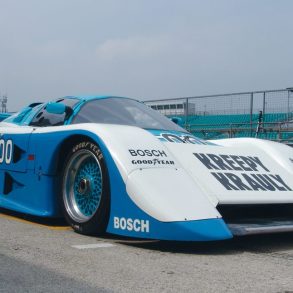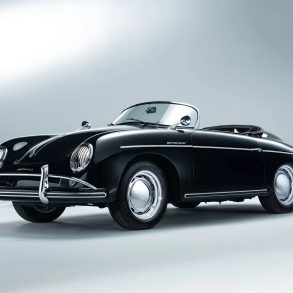From a sensational barn find to a work of beauty with a patina that is as good as the day it rolled out of the factory: the first 1967 Porsche 911 S Targa delivered in Germany is back on the road again after a comprehensive factory restoration that took more than three years by the Porsche Classic Factory Restoration department.

The one who discovered the hidden gem in a garage in the USA is a long-time Porsche enthusiast and collector.
“The Targa stood there for almost 40 years in a garage. The 911 S Targa was delivered to the Porsche dealer Hülpert in Dortmund on 24 January 1967. The restoration is a special project for us – after all, one of the first 911 Targa models has found its way back to Zuffenhausen.”
Uwe Makrutzki, Head of Porsche Classic Factory Restoration at Porsche AG.

The Targa found in the barn is a soft-window version rather than the glass window that was possible from 1967. There were only 925 units of the Porsche 911 that had an S engine, short wheelbase, as well as soft windows manufactured by Porsche from 1966 until 1968.
When found, the rare sports car was in a very poor state. Initially, the car was used as a demonstration car for a Porsche dealer until it was bought by a customer in the USA in 1969. From 1977, the open-top 911 was left in its garage time-capsule in Long Beach, New York State until the end of 2016.





On the upside, the example was found complete, including its optional extras such as the tinted windscreen, Webasto auxiliary heater, leather seats, Blaupunkt Köln radio, outside thermometer, and halogen fog lamps.
One of the philosophies of the Porsche Classic Factory Restoration department is that the vehicles should be restored as true to its original as possible.




Unfortunately, one of the biggest challenges that the team faced was finding authentic small parts like the rubber grommets and sealing plugs for the 2.0-liter S engine.
“Replica parts from third-party suppliers are out of the question for us. Luckily, we can reach into our ‘treasure chest’ in such cases.”
The ‘treasure chest’ is the central warehouse of the Porsche Classic which holds more than 60,000 different genuine spare parts. Another weapon in their arsenal is that their in-house specialists have at their disposal the original frame gauges, straightening sets, technical drawings, and data sheets.
Another hurdle they ran into was the Targa roof’s outer skin.
“Today’s material has a different grain and is more robust than the original. But our customer did not like it. For this reason, we had a visually identical cover produced especially for this project. In spite of their decades of experience, our experts still had to work gradually towards achieving the right finish, that is to say its bonding and stitching.”
Maintaining the desire to stay true to its original, the client requested that the chassis parts, air cleaner system, and the engine panels be coated using the process that was originally used on the parts -the application of a two-component paint in black, just like they did in 1967. This contrasts with the current robust powder coating that is normally used today.

Approximately 1,000 hours of work was done on the body within completed in hand-painted Polo Red, the exact color that it had when it was delivered more than 50 years ago.





As the owner did not just simply want to just collect the 1967 Porsche 911 S Targa but also wanted to enjoy driving it, an application of a painted-on paint protection film was applied. The technology allows it to be removed at any time, including after many years without leaving any residue as it does not utilize adhesive.
In total, the project took Porsche Classic Factory Restoration more than three years to bring the example back to near new condition, including the beautiful patina. The Targa owner already has the teams’ next project sitting in the Porsche Classic workshop waiting for its turn to be restored – a very early 928.




About the Porsche 911 Targa
Porsche launched the 911 Targa at the IAA in 1965, announcing it as the first “safety cabriolet” in the world.
It featured a roll-over bar with a 20-centimeter width, a removable roof, and a rear mini soft top with a plastic window. This was Porsche’s answer to the discussion happening in the USA that tagged cabriolets as dangerous.

Shortly after a Panorama rear window with heatable glass models was released. The open-top variant was named “Targa” and the name came from the Targa Florio endurance race on Sicily that Porsche already was victorious in four times. Compared to the Coupé, the additional cost for the Targa was DM 1,400.
[Source: Porsche AG]











Wow, what a beauty!
Question: what is the painted on paint protection that was used?
Is is available on the market?
It took Jaguar until 1964 to present a similar car, the XJ-SC, which was also the first Jaguar XJ-S with a 6 cylinder engine. Sold it recently to the man who sold it to me 16 years ago and regrettet it for 16 X 365 days that he did so!